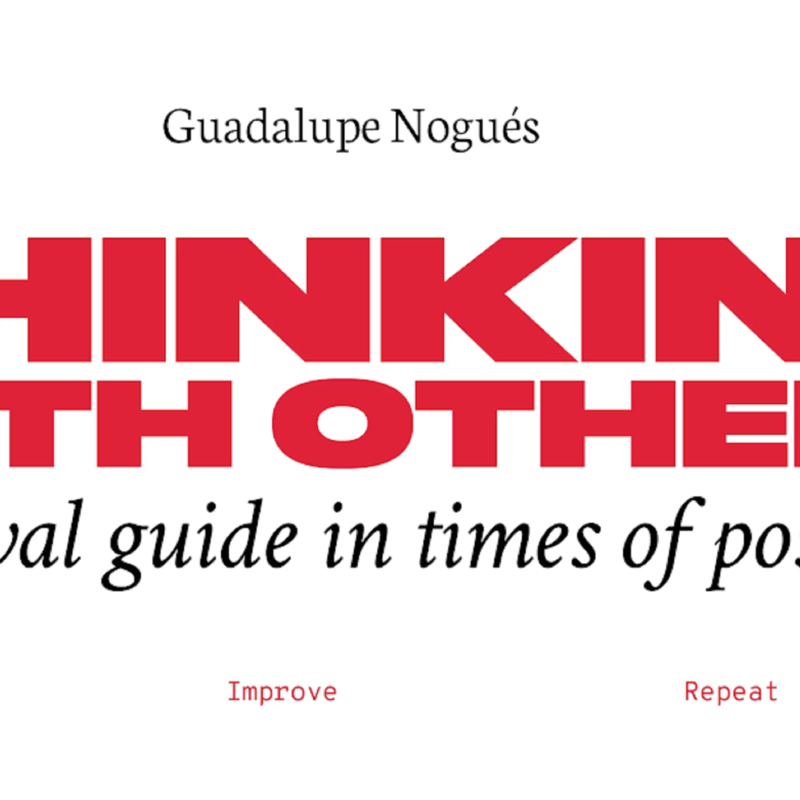Search
Thinking with Others. A survival Guide in times of post-Truth - Of Words and Things, Chapter 1
DOI: 10.17160/josha.7.2.646
Below is the introduction, preface and first chapter of the book Pensar con otros. Una guía de supervivencia en tiempos de posverdad (Thinking with others. A survival guide in times of post-truth), published in 2018. A book that aims to be a starting point to break down post-truth into its main components through concrete examples, as a way to better prepare ourselves to identify the structures that foster post-truth and thus achieve, together, survival and victory. Post-truth allows facts to become facts as long as they fit the desires of each group, of each tribe. Each of these groups develops its own narrative with a language that privileges the capacity to provoke emotions, and pushes those emotions to build landscapes only accessible to those who share the way of looking at them. This discontinuity in the landscape is a threat to the existence and development of meaningful human bonds, to our coexistence as a species on this planet and, thus, to our survival.
Stage fright - blessing or curse?
DOI: 10.17160/josha.7.2.645
Whether it be a surgeon or a performing artist, most people experience stage fright at some point in their lives. Varying levels of anxiety put stress on the body and impact one’s ability to perform, however, the ability to cope with a given situation leads directly to positive or negative outcomes. Franziska Buttgereit is a mezzo-soprano who has been a member of the Freiburg Theatre's extra choir since 2010 and its first director since 2017. In 2015 she began her singing studies with Prof. Christiane Libor at the Musikhochschule Schloss Gottesaue in Karlsruhe and has been collaborating with the University of Music and the Stadttheater Freiburg, which has led to a small role in performances and the DVD production of the same name "Cendrillon" by Jules Massenet.
Architectural Design Process: Consulting with Nature
DOI: 10.17160/josha.7.2.643
In the continuum of evolution and adaptation of living organisms, ranging from microorganisms to human beings, there are certain cycles of time that carry with its cardinal changes that human beings must face and find the best possible harmony of eligibility. The new millennium brings with it a new lifestyle as a result of a number of determining factors, driven by technology development and the phenomenon of globalization. Therefore, we have come into a situation where a number of questions need to be raised about the necessity of redefining many daily life habits. The study presented in this paper investigated the architectural design process to consult with nature, where to many urban structures are being ruined in the name of sustainable architecture. We are constantly experiencing original situations known by intuition, but we have forgotten them, remembering the same thing can be ten times faster.
Editorial Volume 7, Issue 1
DOI: 10.17160/josha.7.1.641
Dear JOSHA readers, once again we find ourselves saying goodbye and closing another issue. This time it is the first one for the year 2020, which is full of important changes for our non-profit journal. Among other things, we must inform you all that our editorials will be published every two months, that is, from 2020 all our issues will be published bimonthly, always on the 30th of every second month. We also like to remind that you can upload a video link of YouTube to your article!
Assessment of the (Inter) Dependency of Economic Relations between Nigeria and China: 1999-2019
DOI: 10.17160/josha.7.2.639
This paper examines the economic bilateral diplomatic relationship between Nigeria and China, especially since Nigeria returned to democracy in 1999. The paper argues that while official diplomatic ties were established between the two countries as early as 1970, there was not much bilateral economic, even political, relations between them until recently. However, since 1999, which coincided with the Chinese new orientation towards Africa, there has been an exponential economic relationship between the two countries. The main question this paper grappled with is whether the relationship between the two countries is inter-dependent or not? The paper is wholly qualitative and gathered its data mainly from secondary sources. The paper is based on the dependency theory and the theory of unequal exchange.
El Gato y la Caja - The Cat in the Box: About Us
DOI: 10.17160/josha.7.1.636
This article presents the work of an exceptional journal from Argentina. We have had the pleasure to be working with some of the Authors of El Gato who are following the same dream as we are. This Journal shares the ideal of many scientists, the idea of exploring possible phenomena located around us as a way of understanding what we do. They, El Gato y La Caja (The Cat and The Box), is a Communication, Research and Design initiative aiming to spread to as many people as possible the idea of science not as a thing we do but as a way of observing and making sense of the world and to contribute to the construction of better, fairer societies. This journal sees the world and knowledge similar to the way JOSHA sees it, sharing and communicating Information through an open-access platform.
A Two-Path Process Model of Invention: Conclusions from six years of Research with independent Inventors
DOI: 10.17160/josha.7.1.629
This paper introduces a two-path model of the invention that comprises two processes: a long-term, idea-driven path, and a short-term, problem-solving path. The model focuses on individual inventors and includes the success factors for the invention that are known from the literature. The model resumes the line of research in independent inventors and responses to five open issues that are central to current research on inventors: the role of creativity; the high level of persistence amongst inventors; the role of knowledge; the permanent transgression of domains by inventors; success criteria. The paper contains an extended review of the state of research on inventors and presents current approaches to explaining inventiveness. A core assumption of the paper is to understand the invention in the context of long-term technological development.
Fridays for Future: Environmental Sustainable Architecture Collection of Research Papers
DOI: 10.17160/josha.7.1.627
This Monograph is originally and especially dedicated to the students of The architecture of the University of Prishtina for Educational, and Not-for-profit purposes. The monograph incorporates research papers published at JOSHA, as a part of FridaysForFuture actions. Seeing the lack of literature in the field of Environmental Architecture, especially in the University of the Prishtina “Hasan Prishtina”, I was inspired by the community of #FridaysForFuture research papers, hence, our small contribution with writing this monograph. The book is a free and not-for-profit purpose, it is indented as basic literature of courses which I taught at the University of Prishtina. In the monograph I have presented research models, design typology, drawings as the cases studies for future generations at the Department of Architecture. There are six papers assembled in one monography presenting the issues regarding the Climate, Environment, and Sustainable Architecture.
Freedom of Expression as Threat to National Security: Self-Determination, Radio Biafra and the Political Space in Nigeria
DOI: 10.17160/josha.7.1.626
A wave of renewed agitation for the creation of the sovereign state of Biafra has gained momentum and is sweeping across the south-east of Nigeria. The Independent People of Biafra (IPOB) is championing the cause. This resuscitated agitation for a sovereign state of Biafra takes a new dimension with the setting up of Radio Biafra and many other internet fora carrying on the struggle for the break-up of the Federal Republic of Nigeria. Unlike other initiatives directed towards achieving the same objective, the current attempt seems to have achieved greater notoriety and succeeded in galvanizing certain segments of the Igbo community who feel victimized and alienated by the current arrangements in Nigeria into a renewed hope and zeal for the secession of Biafra from Nigeria. The arrow-head of the group is Nnamdi Kanu who, among other things, has been accused of advocating violence in order to obtain independence.
Editorial Volume 6, Issue 11
DOI: 10.17160/josha.7.1.625
2020 has begun and our work to share as much knowledge as possible continues. The beginning of this year has not only brought several changes in all the different areas of society and the world but it has also brought us new goals and purposes. As far as JOSHA is concerned, we will begin this new volume by informing you that our future editorials will be published on a quarterly basis. In addition, we would like to take this opportunity to announce our annual competition, the Demetrios Preis, which is for those who would like to participate and publish their researches. We invite you to send us your graduate work in the three different categories of Bachelor, Master, and P.h.D., our editors are ready to read them!



.jpg?1583079463)





.jpg?1578604219)